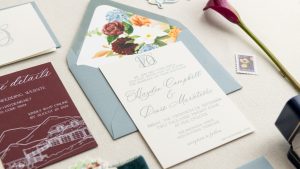Signed, Sealed, Delivered: What’s Included on Your Invitation
Featured Photo by Kim Hymes Photography | Stationery by Robbin’s Nest Design Studio
Yes, you’ve been knee-deep in wedding planning and dreaming since your engagement, but your guests’ first entry into your wedding world comes with the invitations. The stationery (or invitation) suite is the place to really set the scene for your celebrations. Couples have the opportunity to communicate a lot more than just the date and time on their wedding invitations. A wisely crafted invitation suite can share everything from event logistics to the overall feel to attire expectations.
In a digital world, formal invitations sent in the mail are a treasured rarity. So it can be confusing to understand the details like how to address them, how to word the invite itself and whom to include in the address.
A good designer can make sure the stationery aesthetics are just right, but you have to know what details to print on them! Here is a quick guide to what information to include and how to say it.
WHAT TO INCLUDE ON THE INVITATION
- HOST LINE
Start off the invitation with who is hosting the festivities. In the past, this opening line often referenced the bride’s parents, but nowadays we see weddings hosted by the couple themselves, both sets of parents, one set of parents or an omission of this line altogether. It isn’t necessary to include the names of all the hosts, a simple “Together with their parents […]” gets the message across.
- THE REQUEST TO ATTEND
Not to be overlooked, be sure to ask for the pleasure of your guests’ company. It might seem obvious, but including an explicit invitation to attend lets guests know they are excitedly welcomed to the celebrations. There are many ways to phrase this request, depending on formality and your personality. Here are some examples:
- “[NAME & NAME] request the honor of your presence […]”
- “[NAME & NAME] invite you to celebrate with them […]”
- “[NAME & NAME] would love for you to join […]”
- “[NAME & NAME] invite the pleasure of your company […]”
- WHO IS GETTING MARRIED
If not already named in the host line, this is your time to loudly and clearly let your guests know who is getting married! Often, this part of the invitation gets some special typographic treatment and can be printed large and in a statement script. Formal invitations often include the full names of each partner — so get ready to show off your middle name!
- DATE AND TIME
Depending on the formality of your event, you can write out the date and time in full, or you can use numerals. Whatever works best for you! Formality aside, the most important thing is to be clear and avoid confusion. Some fonts have numerals that are hard to read, so if you’re using figures be sure to select a clear font with no room for misinterpretation.
In the past, writing out the year was optional, but as weddings are being planned more and more in advance, it is wise to include the year no matter what.
- LOCATION
It is important for guests to know exactly where they are expected to be! Include the name of your venue and its full address (street, city, state and ZIP code). Some venues with straightforward locations do not require the address to be spelled out entirely, but no matter what, you should include the city and state. This shows guests right off the bat where they should be planning their travel (if needed).
- RECEPTION DETAILS
Some invitation suites include a separate stationery piece with all the reception details, or it can be printed on the main invitation if space allows. If your reception is at the same venue as your ceremony, phrasing like, “reception to follow” will suffice. However, if there is a different location, be sure to clearly note its address and arrival information. When there is a separate venue for the reception, this is when an additional stationery piece is useful.
- DRESS CODE
While not absolutely necessary, including a dress code guide for your guests is helpful as they plan to attend your big day. Not to distract from the main event (your wedding details!), include dress code guidance in the bottom corner of your invitation, or use a separate details card to communicate this information. While the style of the invitation itself should communicate the level of formality expected, spelling it out helps.
Dress Code Examples:
- Black Tie
- Formal or Black-Tie Optional • Cocktail
• Semi-Formal
• Beach Formal
• Festive
• Garden Party
• Smart Casual
• Casual
- RSVP INSTRUCTIONS
Lastly, let your guests know how they can accept with pleasure or decline with regrets. RSVP is short for “Répondez, s’il vous plaît,” which means “please respond” in French. It is common for the RSVP information to be included on a separate response card for guests to complete and mail back to you by a specific date. However, many couples are saving on postage and track their RSVPs via a wedding website or other online platform. Whatever method you decide, be sure to clearly communicate how your guests are to respond.
Browse invitation inspiration here – and search for a local stationery shop now!




